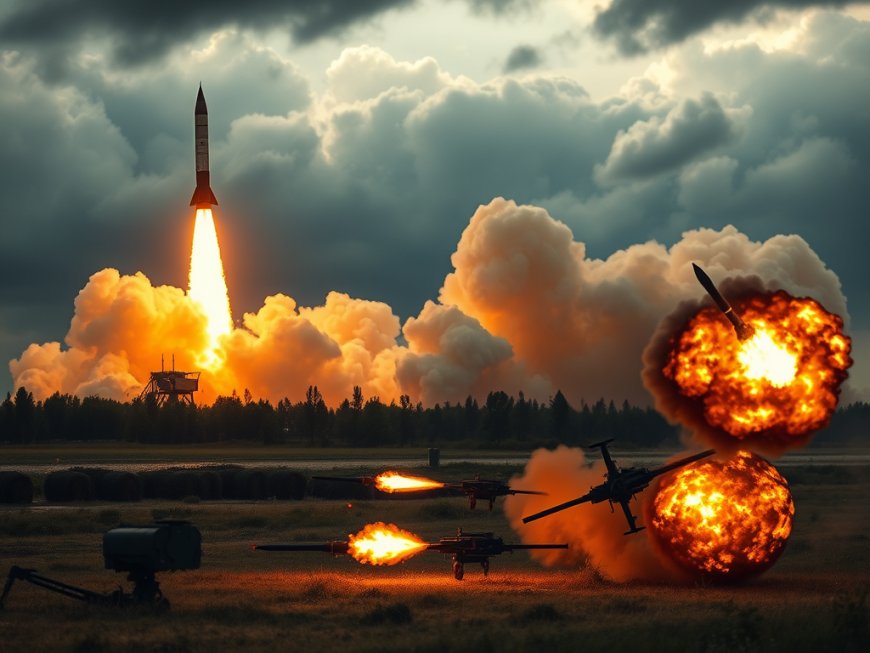Russia and Ukraine Engage in Escalating Missile Conflict
The ongoing Ukraine-Russia conflict has escalated, with Ukraine utilizing U.S. ATACMS and British Storm Shadow missiles against Russian territory. In retaliation, Russia launched missiles at Dnipro, claiming an ICBM was used, which U.S. officials disputed. International reactions have surged, raising concerns over potential broader conflicts and humanitarian impacts.

Latest Developments in the Ukraine-Russia Conflict
In a significant escalation of the ongoing conflict between Russia and Ukraine, Russian forces have launched a series of missiles at the eastern Ukrainian city of Dnipro. The attack, which occurred on Thursday, follows a critical shift in Western policy allowing Ukrainian forces to use U.S.-made and British-supplied missiles to strike targets within Russia.
Background of the Conflict
The recent missile exchange is a direct response to Ukraine's first use of U.S.-made ATACMS (Army Tactical Missile System) missiles to target Russian territory earlier in the week. This move was authorized by U.S. President Joe Biden, who lifted restrictions on the use of these long-range missiles inside Russia[1][2].
Russian Retaliation
Russia's retaliation was swift and severe. According to Ukraine's air force, Russian forces launched what Ukraine claims was an intercontinental ballistic missile (ICBM) at Dnipro. However, U.S. officials have contradicted this, stating that the missile was actually a shorter-range ballistic missile, possibly an intermediate-range ballistic missile (IRBM), launched from near Volgograd, Russia[1][2].
Table: Details of the Russian Missile Attack
| Aspect | Description |
|---|---|
| Type of Missile | Ukraine claims ICBM, U.S. officials say IRBM |
| Launch Location | Astrakhan region on the Caspian Sea (Ukraine's claim) or near Volgograd (U.S. officials) |
| Target | Dnipro, Ukraine |
| Additional Missiles | Kinzhal hypersonic missile and seven cruise missiles |
| Defensive Measures | Ukrainian air defenses shot down six cruise missiles |
| Damage | Industrial enterprise damaged, fires ignited, 15 people wounded |
Use of Advanced Missiles
The attack on Dnipro involved a mix of advanced weaponry, including a Kinzhal hypersonic missile and seven cruise missiles. Despite Ukrainian air defenses managing to shoot down six of the cruise missiles, the strike still caused significant damage and wounded several people[1][3].
British Involvement
In addition to the U.S.-made ATACMS missiles, Ukrainian forces also used British-made Storm Shadow missiles to target Russian territory. This development follows British officials' earlier hints at aligning with the U.S. in granting Ukraine permission to use these missiles against Russia. Russia's Defense Ministry reported that its air defense systems shot down two Storm Shadow cruise missiles aimed at targets in the Kursk region[3].
International Reactions and Concerns
The escalation has drawn significant international attention and concern. Ukrainian President Volodymyr Zelenskyy accused Russia of using Ukraine as a "training ground" for its new weapons and emphasized that the characteristics of the missile used in the strike corresponded to those of an ICBM. An investigation is underway to confirm the type of missile used[1][3].
Russian officials, including Kremlin spokesman Dmitry Peskov and Foreign Ministry spokeswoman Maria Zakharova, have been cautious in their responses. Zakharova was instructed during a live briefing not to comment on the alleged ballistic missile strike, adding to the mystery surrounding the incident[3].
Geopolitical Implications
The deployment of North Korean troops to Russia's Kursk region has further complicated the situation. The U.S. and its allies view this move as escalatory and have adjusted their military aid policies accordingly. The change in policy aims to deter North Korea from sending additional forces and to support Ukraine in its defense efforts[1].
At the Group of 20 summit in Brazil, British Prime Minister Keir Starmer emphasized the need to ensure Ukraine has the necessary capabilities to defend itself, without delving into operational details to avoid benefiting Putin[3].
Conclusion
The recent missile exchanges between Russia and Ukraine mark a dangerous escalation in the conflict. As both sides continue to employ advanced weaponry, the international community remains on high alert, concerned about the potential for further escalation and the broader implications for global security.
List: Key Points in the Escalation
- Ukraine's Use of ATACMS Missiles: First use of U.S.-made long-range missiles to target Russian territory.
- Russian Retaliation: Launch of what Ukraine claims was an ICBM, but U.S. officials describe as an IRBM.
- British Involvement: Use of British-made Storm Shadow missiles by Ukrainian forces.
- North Korean Troops: Deployment of over 10,000 North Korean soldiers to Russia's Kursk region.
- International Concerns: Warnings from the U.S. and its allies about potential escalation and the risk of a broader conflict.
- Humanitarian Impact: Damage to industrial enterprises, fires, and injuries in Dnipro.

